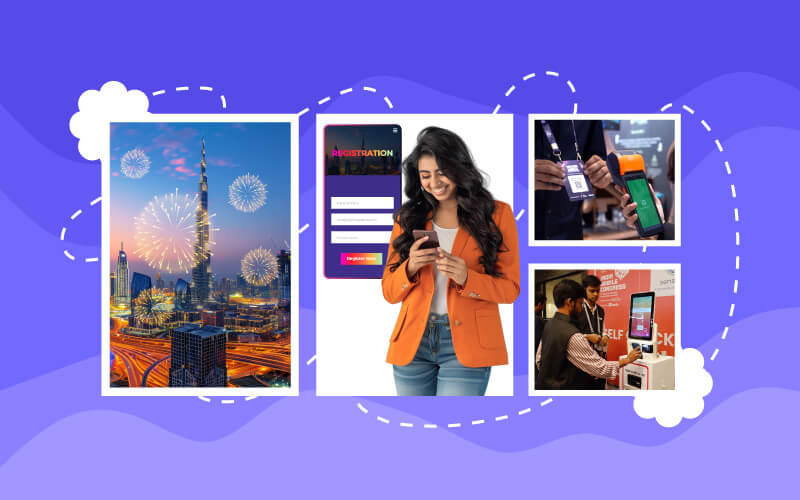Curious about best practices for event registrations? There’s no doubt that for a successful event, the base is top-notch smooth event registration. It’s more than just a formality; it’s the major pillar of a successful event. It leaves a lasting impression on potential attendees in the first interaction with ultimate satisfaction.
With continuous competition growing in the event industry, staying out of the box requires more than sticking to a basic event registration form, traditional check-in methods, etc. To succeed in the market, best practices for event registration should be followed, which include streamlined planning, execution and everything until post-event.
Let’s start discussing essential steps for smooth event registration to deliver an exceptional experience for the audience.
8 Winning Best Practices for Event Registration Success
Now, let’s dive deep into the effective event registration tips for the seamless and flawless execution of the event:
1. Planning of Event Registration: Lay out the Foundation for Success
The list of best practices for event registration starts with finalizing the layout of event registration, which ensures a smooth attendee experience, valuable data collection, and efficient event management.
- Set clear objectives
Identify the primary goals of the event registration process. As an event host, what do you want to achieve? Ask yourself: Is it maximized attendance, participant data for marketing purposes or aim to deliver on-site check-in? For instance, if your goal is to collect attendee data for future marketing, then the focus should be on designing a form that captures essential information, demographics, and strategic questions to gain deep insights and interests.
- Identify the Target Audience
Without a target audience, the event becomes unprofitable. Therefore, a deep understanding of the target audience is essential for creating a personalized experience. Delve deep into detailed attendee demographics, interests and expectations. As a result, this information assists in crafting targeted messaging, advertisements, and relevant registration questions.
2. Selecting the Right Registration Platform: Meet Specific Requirements
Picking up the right registration platform, like Dreamcast, is one of the critical decisions to make after determining the objectives. Evaluating various options based on the size of the event, budget, desired features, and integration capabilities is considered one of the best practices for the event registration process.
Consider factors such as:
- Can an event registration platform handle your expected number of attendees?
- Is the platform easy to navigate for both, organizers and attendees?
- Can you tailor the registration process to match your event branding?
- Does the event registration platform integrate with other tools you use, such as CRM or email marketing?
- Does the platform fit within the event budget with nice pricing?
However, for positive feedback from attendees, the registration and ticketing platform should be solely focused on the easy user interface, being mobile accessible and well-planned event check-in to enhance overall satisfaction. Here are features that need to be kept in mind:
- User-Friendly Interface
Smooth event registration is based on a well-designed user interface which is easy to navigate and understand. Avoid troubling attendees with excessive information and complex interfaces. Ensure to use clear, short and concise language with a logical flow visually appealing to enhance engagement.
- Mobile Accessibility
We live in a mobile-centric era where mobile is a constant companion. Therefore, by prioritizing mobile accessibility, one can reach a wider audience. Make sure to bring all attention towards responsive mobile app design with touchscreen compatibility along with mobile-optimized payment gateways for convenience.
Read More: Why you need the right event registration platform?
3. Customizing Registration Forms: Keep It Simple

Now, the real hassle begins with designing registration forms for attendees. Be selective about required and optional fields and incorporate conditional logic while optimizing data collection and enhancing overall attendee satisfaction. Here are some best practices for event registration forms to consider:
- Essential Information to Collect
While all the essential information required will be different based on the event, here are some standard fields to include.
- Basic attendee information: name, email address, phone number, organization (if applicable)
- Event-specific details: ticket type, session preferences, dietary restrictions, accessibility needs
- Demographic information: age, gender, industry, job title (optional)
- Contact preferences: Email, SMS, or phone for event updates and communications
- What are Optional vs. Required Fields?
There should always be a balance between required and optional fields required for a smooth event registration process. Here’s a table with essential and optional fields;
| Required Fields | Optional Fields |
| Full Name | Job Title |
| Email Address | Company Name |
| Phone Number | Dietary Preferences |
| Payment Information | How Did You Hear About Us? |
| Ticket Type | Additional Comments |
| Address (if needed) | Social Media Handles |
| Event Session Choice | Preferred Contact Method (e.g., phone or email) |
| Emergency Contact Details | LinkedIn Profile |
| Organization Type | T-shirt size (for events with merchandise) |
| Accessibility Needs | Hobbies/Interests |
- Personalized Experience
To provide a more personalized registration experience to attendees, leverage the power of conditional logic for event registration forms. Try displaying or eliminating fields based on previous answers from attendees; this way you can streamline the entire process while gathering relevant information. Here’s an example:
- Show extra questions based on the ticket type attendees choose.
- Provide specific options for dietary requirements if attendees mention any restrictions.
- Offer more choices for communication preferences if attendees agree to receive emails.
- If attendees do not select any session preferences, skip related questions about preferred sessions.
4. Payment Processing and Ticketing: Effortless and Smooth Transactions
According to a study, 29% of people abandon online forms because of security concerns. Therefore, a seamless payment process is very important for a positive impact on attendees. Best practices for event registration include offering secure payment gateway options with clear pricing information and automation of ticket generation. As a result, it’ll not only maximize revenue but also boost overall satisfaction.
What are these secure payment gateways?
A secure payment gateway includes multiple options for processing payments to cater to various attendee preferences with complete prevention against fraud, security protocols like payment card industry (PCI), decision support system (DSS) and convenience.
What are the Multiple Payment Options?
- Credit cards: Major credit cards (Visa, Mastercard, American Express, Discover) are widely accepted.
- Debit cards: Provide options for debit card payments.
- Digital wallets: Integrate popular digital wallets like Paytm Wallet, Google Pay, and PhonePe. In countries like the UAE, Apple Pay, and PayPal cater to users who prefer digital payment solutions.
- Offline payment options: For certain events or certain attendees who don’t prefer cashless methods, consider offering cash or check payments.
How Does Automated Ticket Generation Ease Event Tickets?
After the completion of payment, leverage automating ticket generation to save time and eliminate errors. The system should automatically generate digital tickets and send them to attendees via mobile event app, email, or text message. Digital tickets include incorporating unique identifiers for easy check-in, such as a barcode or QR code scan. Therefore, by focusing on streamlining the ticket generation process, you provide a convenient and efficient experience for attendees.

5. Promoting Your Event: Build-Up Anticipation and Drive Registrations
According to research, 77% of participants say that their trust increased and they followed their interaction with a brand at a live event. By leveraging various marketing channels and crafting compelling messaging, you can build anticipation and encourage attendees to sign up.
It’s time to follow another event registration tip, i.e., effectively promoting the event and driving more registrations. Utilize social media, compelling content marketing, and marketing channels to build hype and anticipation to encourage attendees to sign up. Here’s how you can do it:
| Promotion Strategy | Simple Actions |
| Leveraging Social Media | Share Content: Post exciting updates, behind-the-scenes looks, and teasers. Example: Share a countdown on Instagram about the event with daily posts. |
| Use Hashtags: Increase visibility. Example: #EventName2024. | |
| Run Contests: Offer prizes to encourage people to share and engage. Example: Run a giveaway for free tickets to those who share your event post. | |
| Pay for Ads: Reach target audience. Example: Ads for event topics. | |
| Email Marketing Campaigns | Build Your List: Collect emails. Example: Offer a free guide. |
| Segment Your List: Tailor messages. Example: Send different emails to those who signed up for workshops versus networking events. | |
| Write Great Emails: Craft interesting subject lines and provide useful content. Example: Use subject lines like “Don’t Miss Out on Our Biggest Event of the Year!” | |
| Track Performance: Optimize campaigns. Example: Monitor open and click rates. | |
| Collaborations and Partnerships | Partner with Others: Cross-promote events. Example: Discounts with local businesses. |
| Work with Influencers: Extend reach. Example: An influencer shares your event. | |
| Collaborate with Media: Team up with media outlets to spread the word about your event. Example: get featured in local newspapers or radio shows. |
6. Managing Attendee Data: Build Long-Term Relationships

In order to build more networking relationships with attendees, prioritize effective management of attendee data. Implement data security with access controls and data protection regulations like the General Data Protection Regulation (GDPR) and the California Consumer Privacy Act (CCPA).
Moreover, integrating registration data with the event CRM can streamline entire attendee management. As a result, all attendees can be easily accessed on a single platform. However, event CRM tools also assist with effective communication, sales and lead generation by identifying potential business opportunities.
Why Is Real-Time Data Access Considered a Best Practice for Event Registration?
Event planners need to keep track of real-time updates of attendees, as it empowers them to make informed decisions during the event planning process. Here’s why:
- Attendee insights: Analyze event registration data to understand attendee demographics, choices and interests.
- Inventory management: Monitor entire event ticket sales and adjust inventory accordingly.
- On-site Event Management: Track attendee event check-ins and manage indoor/outdoor event management and risk management.
- Post-event analysis: Evaluate event performance and identify areas for improvement.
7. On-Site Registration and Check-In: A Smooth Start to the Event
Managing onsite registration and check-in in a well-organized form requires efficient event check-in solutions that provide clear signage, seamless last-minute registrations, and effortless onsite badge printing. Here are the best practices for event registration to consider:
- Efficient Check-In Solutions
Quick and robust onsite event solutions streamline the check-in process by eliminating waiting times and ensuring a quick entry. Here’s how this can be achieved:
- Dedicated check-in stations: Establish clearly marked event check-in areas with sufficient staff for registration with desks.
- Utilize Registration Technology: 44% of event attendees agree that technology makes consuming events easier. Therefore, utilize registration platforms or dedicated event apps to expedite the check-in process.
- Barcode or QR code scanners: Speed up attendee verification by scanning QR code tickets or smart event badges.
- Self-service kiosks: Implement self-check-in options for attendees who prefer a hands-off approach, like event check-in apps or self-service kiosks.
- Onsite badge printing and access control
Providing attendees with name badges for events not only identifies them but also offers additional opportunities for branding and networking. Consider the following:
- Professional badge design: Create visually appealing event badges that display the event’s theme.
- On-site badge printing: Incorporate easy onsite event badge printing for last-minute registrations or changes.
- Access control: Implement smart wristbands or badges with RFID technology for controlled entry to specific areas.
- Badge add-ons: Consider badge options like lanyards, holders, or retractable reels for convenience.
How to handle last-minute registrations?
Have a well-defined plan for last-minute attendees. Be prepared to accommodate walk-in attendees by:
- Dedicated registration area: Designate a specific area for on-ground registration.
- Sufficient staffing: Ensure adequate staff is available to handle last-minute registrations.
- Flexible payment options: Accept multiple payment methods to accommodate attendees’ preferences.
- Contingency plans: Have a backup plan in place for unexpectedly high volumes.
Let’s move on to the final section of best practices for event registrations, “Post-Event Follow-Up.”
8. Post-Event Follow-Up: Nurturing Relationships and Gathering Feedback

Last but not least, keep this event registration tip in mind for every event you host. A successful event doesn’t end with the final keynote. Ensure post-event follow-up activities for building lasting relationships with attendees, gathering valuable feedback, and laying the groundwork for future events. Therefore, it builds a loyal customer base and increases the repeatability of attendees.
Here’s a table with categories mentioned for gathering feedback, analyzing registration data, and nurturing attendee relationships:
| Category | Methods/Strategies | Details |
| Gathering Feedback | Post-Event Surveys | Create detailed surveys on content, speakers, venue, and overall experience. |
| Social Media Monitoring | Track event-related conversations and sentiments on social platforms. | |
| One-on-One Interactions | Engage with attendees during and after the event for qualitative feedback. | |
| Analyzing Registration Data | Attendee Demographics | Identify key segments for targeted marketing. |
| Registration Patterns | Analyze trends to optimize future event timing and pricing. | |
| Ticket Sales | Evaluate ticket performance to assess pricing strategies and package offerings. | |
| Event ROI | Calculate the return on investment based on registration data and revenue. | |
| Nurturing Attendee Relationships | Thank-You Notes | Send personalized messages to express gratitude for attendance. |
| Exclusive Content | Offer special content or resources as a value-added benefit. | |
| Stay Connected | Use email marketing and social media to maintain engagement. | |
| Alumni Programs | Create a community for past attendees to foster engagement and networking. |
Summing Up:
In conclusion, we have covered 8 best practices for event registration. Following these event registration tips ensures the smooth execution of an event with proper planning and management. Starting with identifying the goals and choosing a smooth event registration platform with customized features for forms, a mobile event app, branding to promote the event and following up with post-event strategies, event organizers can maximize the impact of any event, build strong attendee relationships, and gather valuable insights for future planning.







